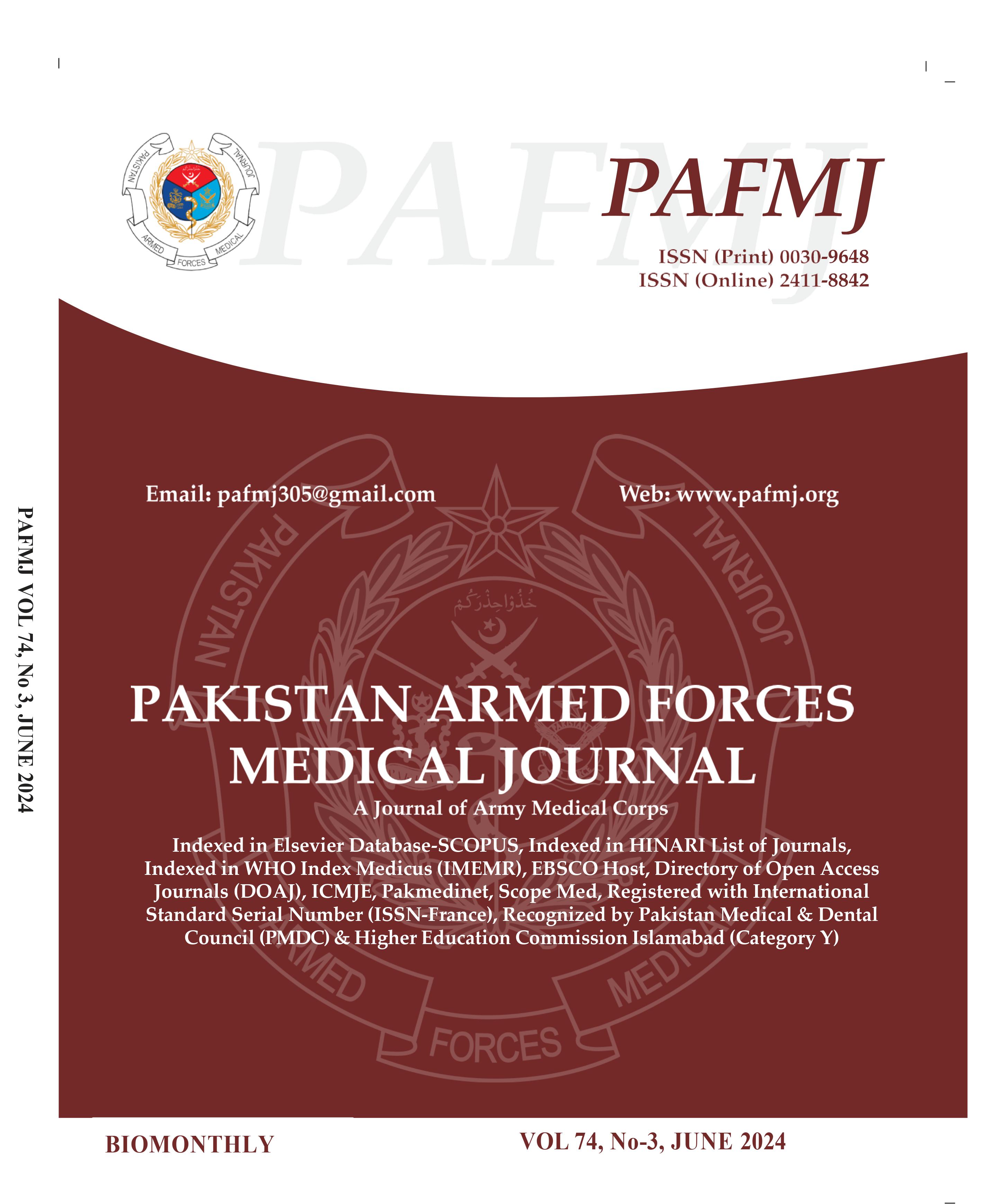Comparison of Maternal Bleeding During Preterm and Term Cesarean Delivery
DOI:
https://doi.org/10.51253/pafmj.v74i3.7213Keywords:
Caesarian, Gestation age. Hemorrhage, PregnancyAbstract
Objective: To compare maternal bleeding in pregnant women undergoing term and pre-term Cesarean delivery.
Study Design: Comparative cross-sectional study.
Place and Duration of Study: Gynecology and Obstetrics Department, Pak Emirates Military Hospital, Rawalpindi, Pakistan Jan to Jun 2021.
Methodology: A total of 211 pregnant women undergoing Caesarian section at our tertiary care center were included in the study. They were divided into two groups based on gestational age as term or pre-term, with delivery at 37 completed weeks being labelled full term. Lower segment cesarean section was carried out by consultant gynecologist on all the patients as per standard protocol and blood loss was compared in term and pre-term Caesarian deliveries.
Results: Out of 211 study participants, 108(51.1%) had a Caesarian section at term while 103(48.9%) had pre-term Caesarian section. The mean age of participants was 29.35±4.10 years. Mean blood loss during the Caesarian section in term pregnancies was 437.03±129.76 ml while in pre-term pregnancies was 641.26±157.40 ml. Independent t-test showed that bleeding was statistically significantly more in pre-term pregnancies (p-value<0.001). Post-operative hemoglobin was also significantly different in term and preterm pregnancies (p-vale<0.001).
Conclusion: Women undergoing Caesarian section pre-term were at risk of having more blood loss and fall in hemoglobin levels as compared to those undergoing Caesarian section at term.
Downloads
References
Kepley JM, Mohiuddin SS. Physiology, maternal changes. treasure island (FL): StatPearls Publishing; 2020.
Keag OE, Norman JE, Stock SJ. Long-term risks and benefits associated with cesarean delivery for mother, baby, and subsequent pregnancies: Systematic review and meta-analysis. PLoS Med 2018; 15(1): e1002494.
https://doi.org/10.1371/journal.pmed.1002494
Sung S, Mahdy H. Cesarean Section. Treasure Island (FL): StatPearls Publishing; 2021.
Wormer KC, Jamil RT, Bryant SB. Acute Postpartum Hemorrhage. Treasure Island (FL): StatPearls Publishing; 2021.
Blosser C, Smith A, Poole AT. Quantification of blood loss improves detection of postpartum hemorrhage and accuracy of postpartum hemorrhage rates: A Retrospective Cohort Study. Cureus 2021; 13(2): e13591.
https://doi.org/10.7759/cureus.13591
Ashwal E, BergelBson R, Aviram A, Hadar E, Yogev Y, Hiersch L, et al. Risk factors for postpartum hemorrhage following cesarean delivery. J Matern Fetal Neonatal Med 2021; 28(3): 1-5.
https://doi.org/10.1080/14767058.2020.1834533
Pubu ZM, Bianba ZM, Yang G, Cyren LM, Pubu DJ, Suo Lang KZ, et al. Factors affecting the risk of postpartum hemorrhage in pregnant women in tibet health facilities. Med SciMonit 2021; 27(3): e928568.
https://doi.org/10.12659/MSM.928568
Xu C, Fu Q, Tao HB, Lin XJ, Wang ML, Xia SX, et al. Effect of cesarean section on the severity of postpartum hemorrhage in chinese women: The Shanxi Study. Curr Med Sci 2018; 38(4): 618-625.
https://doi.org/10.1007/s11596-018-1922-1
Blanc J, Resseguier N, Goffinet F, Lorthe E, Kayem G, Delorme P, et al. Association between gestational age and severe maternal morbidity and mortality of preterm cesarean delivery: a population-based cohort study. Am J Obstet Gynecol 2019 ; 220(4): 399.e1-399.e9.
https://doi.org/10.1016/j.ajog.2019.01.005
Abbas F, Ud Din RA, Sadiq M. Prevalence and determinants of Caesarean delivery in Punjab, Pakistan. East Mediterr Health J 2019; 24(11): 1058-1065.
https://doi.org/10.26719/2018.24.11.1058
Kino T, Yamamoto Y, Saigusa Y, Aoki S, Miyagi E. Adverse pregnancy outcomes related to preterm cesarean delivery. Eur J ObstetGynecolReprod Biol 2019; 234(3): 89-91.
https://doi.org/10.1016/j.ejogrb.2018.12.033
Pallister M, Ballas J, Kohn J, Eppes CS, Belfort M, Davidson C. A Standardized Approach to Cesarean Surgical Technique and Its Effect on Operative Time and Surgical Morbidity. Am J Perinatol 2019; 36(3): 277-284. https://doi.org/10.1055/s-0038-1667370
Doctorvaladan SV, Jelks AT, Hsieh EW, Thurer RL, Zakowski MI, Lagrew DC, et al. Accuracy of blood loss measurement during cesarean delivery. AJP Rep 2017; 7(2): e93-e100.
https://doi.org/10.1055/s-0037-1601382
Suman V, Luther EE. Preterm labor. Treasure island (FL): StatPearls Publishing; 2021.
Sirgant D, Rességuier N, d'Ercole C, Auquier P, Tosello B, Blanc J, et al. Lower gestational age is associated with severe maternal morbidity of preterm cesarean delivery. J GynecolObstet Hum Reprod 2020; 49(7): 101764.
https://doi.org/10.1016/j.jogoh.2020.101764
Suzuki S, Hiraizumi Y, Miyake H. Risk factors for postpartum hemorrhage requiring transfusion in cesarean deliveries for Japanese twins: comparison with those for singletons. Arch Gynecol Obstet 2012; 286(6): 1363-1367.
https://doi.org/10.1007/s00404-012-2461-9
Reddy UM, Rice MM, Grobman WA, Bailit JL, Wapner RJ, Varner MW, et al. Serious maternal complications after early preterm delivery (24-33 weeks' gestation). Am J Obstet Gynecol 2015; 213(4): 538.e1-9. https://doi.org/10.1016/j.ajog.2015.06.064
Kawakita T, Reddy UM, Grantz KL, Landy HJ, Desale S, Iqbal SN, et al. Maternal outcomes associated with early preterm cesarean delivery. Am J Obstet Gynecol 2017; 216(3): 312.e1-312.e9. https://doi.org/10.1016/j.ajog.2016.11.1006
Downloads
Published
Issue
Section
License
Copyright (c) 2024 Saima Irfan, Rubina Mushtaq, Sumaira Khan, Maliha Khawar, Nafeesa Hiba

This work is licensed under a Creative Commons Attribution-NonCommercial 4.0 International License.















